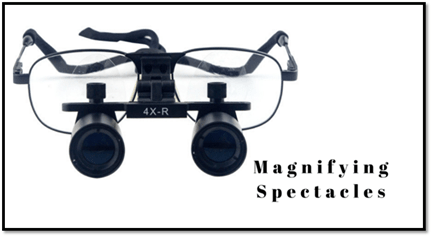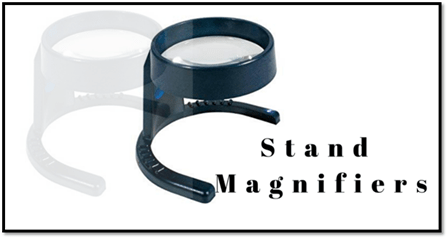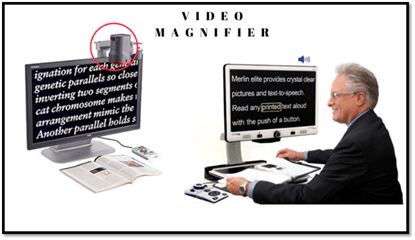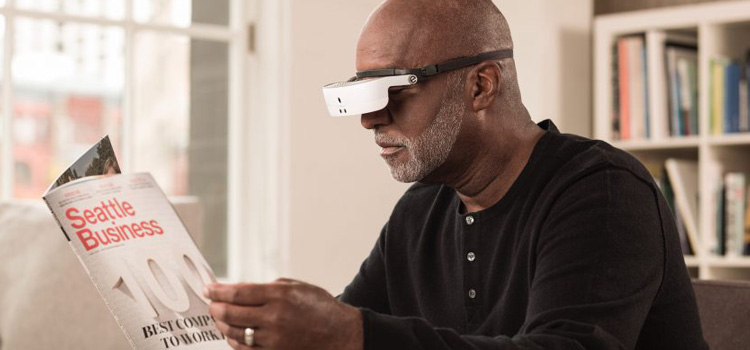Contents
Low Vision Aids
Low vision is a condition in which a person’s visual impairment cannot be adjusted with glasses, contact lenses, or eye surgery. It also refers to vision loss that cannot be corrected by medicinal or operational treatments or conventional eyeglasses. Low vision can affect people of all ages, but it is linked essentially with adults over the age of 60.
It is generated by critical eye diseases like Macular degeneration, glaucoma, retinal detachment, etc. And in conditions in which visual acuity in the better eye is 20/70 or less, or where there is a vital loss of visual field constriction to 20 degrees or less, termed as tunnel vision.
Visual acuity of the person with 20/70 vision who is 20 feet from an eye chart views what a person with perfect vision 20/20 vision can view from 70 feet away.
If you have low vision, your prescription of eyeglasses is usually no longer enough to help with distance and near tasks. Low vision aids consist of a variety of devices, such as a stand and hand-held magnifiers, loupes, and small telescopes. These tools can help you in performing daily activities with ease.
Causes of Low Vision
Causes and common patterns of low vision which cannot be corrected involve:
- Macular degeneration: Blurred or partially covered central vision
- Diabetic retinopathy: Blind spots, blurriness, and optical distortions
- Glaucoma: Reduced peripheral vision, or tunnel vision
- Retinitis pigmentosa: Poor peripheral vision, and failure to see in the dark
- Eye damages
- Optic neuropathies
These conditions cannot be corrected from the surgery or wearing of eyeglasses. Vision correction is only possible in the case of cataract surgery. If these are not the reason, your doctor will lead special tests to discover the cause, type, and severity of vision loss. After the first assessment, he or she will help you take the following steps toward coping with your life situations.
Once the visual loss has been determined, the low vision specialist can guide suitable low vision aids that suit best for your condition and teach you to avail them. There are many low vision aids and devices to help you cope with your problem and make your living easy. The most generally prescribed ones include lighted handheld magnifiers, digital desktop magnifiers, and bioptic telescopes.
How Low Vision Aids Work?
Low vision aids can help in visually navigating the daily challenges that a visually impaired person experiences. With the help of the following tools, one can overcome the limitations of vision loss.
Low vision aids or devices work by enhancing whatever vision you already have. Low vision aids help you regain the specific visual functions by utilizing and maximizing the vision you still have. People with low vision are especially unable to read, whether it is a small print or a newspaper. A high-level magnifier is used to correct it. For those who can barely see, computerized technology that converts text into speech is recommended.
One can consult an eye doctor to ensure that the recommendations are personalized according to the meets of specific vision conditions. Low vision devices have varieties from handheld magnifying devices to advanced telescope glasses and more.
Low vision Aids Technique
People with low vision face difficulty in performing basic activities such as watching television, reading, shopping, cooking, and taking care of their needs. They are concerned about going out, getting around, participating in social activities. Some may also suffer from depression because of this (You can visit our site for effective online depression counseling). If you or your loved one is suffering from low vision, then talk to an eye specialist, healthcare professional for assistance. You should not worry much as you can still live a normal life with low vision devices.
There are countless techniques one can adopt for low vision:
Enhance the Lighting in Your House
Substitute small light bulbs with bulbs of higher wattage to get enough light. Make sure all nooks and crannies are well elucidated to limit falls and gain clear visibility. Having proper light around can help in seeing better, and it is also stress-free for your eyes to cope with low vision aids.
Decrease Glare
Modify light fixtures to reduce shield your eyes from temporary blindness by wearing sunglasses and a wide-brimmed hat or a dupatta/ stole wrapped around your face protecting your eyes.
Use Markers and Highlighters
Practice big, bold felt tip markers for writing a shopping list. Even, you can use a whiteboard to mark important dates and calendars. Bold labels and stickers can be used to make it easy to identify things.
Exclusive Low Vision Aids Devices
Watches, remotes, and thermostats that talk back are also easily available and have reasonable costing. Even in mobile phones, there is a feature for the visually impaired to make it easier for them to commute with the help of maps and search things around with the help of audio features.
Keep The House Clean
Keep the items in their proper places so they are easy to find. And also doing so will keep you safe. Make sure you don’t fall because of the things scattered on the floor. Making a daily routine will be helpful in the long run as well.
Commonly Used Low Vision Aids
There are many low vision aid equipment and tools, some of them are:
Magnifying Spectacles

Magnifying spectacles are worn like eyeglasses and assist in better viewing power for activities like reading, threading a needle, stitching, etc. These are hands-free magnifiers, allowing you to work with your hands.
Stand Magnifiers

These low vision devices usually are positioned on the lenses of eyeglasses and give high magnification while enabling the wearer to see reading material from a healthy distance. Again, some training is required to use these devices well, but reading telescopes often are very convenient. Hand-held versions also are available.
A telescope allows greater participation in daily and social activities such as watching television and reading whiteboards etc. On the other hand, the limitation of visual field and illumination, the problem in finding and concentrating on objects fast, and short focus depth are problems of the telescopes. Telescopes are not completely accepted due to expense, the problem in using the devices, and artistic considerations. Good coordination and training are essential.
Video Magnifiers

A video magnifier system has a monitor and a camera that projects the magnified and large image on the screen. Benefits are greater reading speed i.e., 2.5 times and a higher working distance of 3 times when relating to other aids. The longer working distance makes it simple to use for writing, sketching, or art.
Also gives extra visual field, brightness, contrast, and polarity control, it provides magnification of 2 to 60 times and binocular vision. It can be set or portable, black and white or colour, mouse or tray, and fixed-focus or autofocus, allowing objects to be seen at different distances.
A video magnifier method needs coordination and training, but it is the only service that completely enhances residual vision.
Reading is often one of the most complex challenges for visually week people. Many people with low vision give up reading completely. Because what used to be a fun, effortless activity now requires care, preparation, and a lot of change. Low Vision Devices can benefit and make you able to read again.
Above mention, low vision aid will help to modify your vision. Many low vision tools can make reading more relaxed and satisfying for people with macular degeneration, retinitis pigmentosa, and other low vision diseases.
For getting a service of low vision aid, log into our website EyeMantra. Our professional experts will take great care of your vision and will tell you treatment according to your needs.
You call us on +91-9711115191. You can also mail at [email protected]. We also offer various services like Retina Surgery, Specs Removal, Lasik Surgery, Squint, Cataract Surgery, Glaucoma Surgery, and much more.



